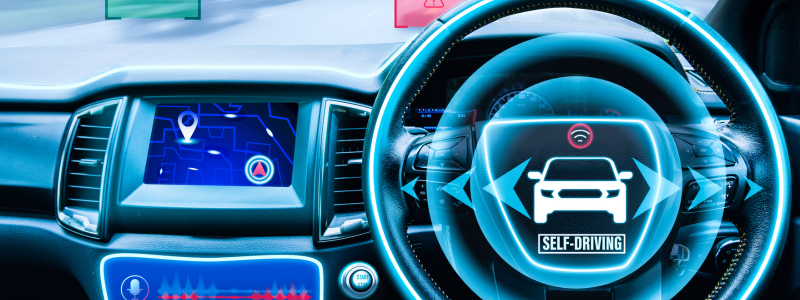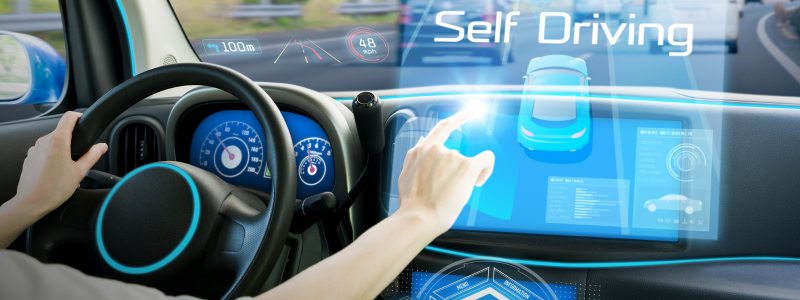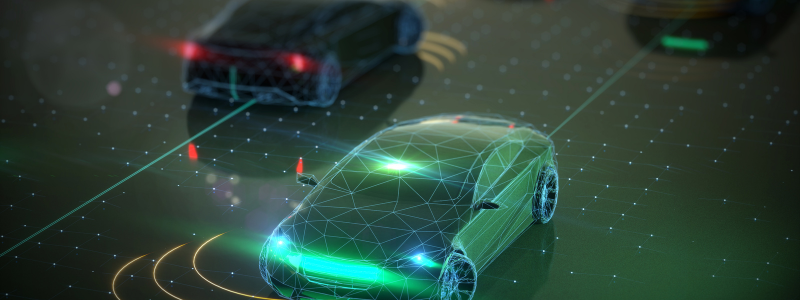Self-Driving Cars: How They Work & Are They Safe? An Analysis
by Will Marsh on Aug 28, 2024 11:20:20 AM
Key Summary
Self-driving cars roam the road without the need for a human. They use complex technology and sensors to assess the landscape and provide this information to the car.
Self-driving cars have benefits:
- Increased safety.
- Reduced accidents caused by human error.
- More efficient roads.
- Communicate with other self-driving cars to reduce traffic.
There are some risks though:
- Cost of technology.
- Loss of human manufacturing jobs.
- Safety risk if defects occur.
Regarding testing, self-driving cars have been tested globally. These tests have produced positive results, but this is just the start of autonomous cars, and more tests will likely follow.
Self-driving cars have been a topic of conversation for years, but as technology advances and more tests are conducted, it’s becoming increasingly clear that they’re not just a pipe dream. Self-driving cars have the potential to revolutionise the way we travel, making our roads safer and more efficient and transforming the way we live and work.
For motor enthusiasts and automotive aficionados, the emergence of self-driving cars marks a pivotal moment in the evolution of the motor sector. This rapidly evolving landscape presents an irresistible blend of innovation and transformation, where man and machine share the driver’s seat. In this article, we’ll embark on a journey to demystify self-driving cars, exploring their mechanisms, merits, and potential drawbacks. We’ll also navigate the uncharted terrain of personal preferences, shedding light on whether die-hard driving enthusiasts will shift to the autonomous realm.
👉 How do self-driving cars work?
👉 What are the benefits of self-driving cars?
👉 What are the negatives of self-driving cars?
👉 Will people who ‘Enjoy Driving’ switch to a self-driving car?
👉 Where are self-driving cars being tested? What are the results of those tests so far?
👉 Enhanced safety through vehicle-to-vehicle (V2V) communication
👉 Data-sharing and AI integration for enhanced decision-making
👉 Challenges and opportunities in the era of connected vehicles
👉 A collaborative future
👉 Finance your new car!

What Are Self-Driving Cars?
Self-driving cars, also known as autonomous vehicles, can sense their environment and navigate roads without human input. They use a combination of sensors, cameras, and artificial intelligence algorithms to understand their surroundings and make decisions about navigating roads, avoiding obstacles, and interacting with other vehicles.
How Do Self-Driving Cars Work?
Self-driving cars, also called autonomous vehicles, harness an orchestra of technologies to decipher their surroundings and navigate the open road. These technological virtuosos rely on a symphony of sensors—radars, lidars, and cameras—working harmoniously with GPS and AI algorithms. This cutting-edge hardware and software fusion empowers them to weave seamlessly through traffic, dodge obstacles, and harmonise with fellow road travellers.
The mechanics of self-driving cars play out on a digital stage where data orchestrates their every move. Radars and lidars act as their eyes, mapping the road ahead in intricate detail, while AI algorithms interpret this visual symphony to make real-time decisions. By analysing traffic patterns and foreseeing potential hazards, these autonomous maestros navigate with an uncanny finesse that human drivers can only aspire to achieve.

What Are The Benefits Of Self-Driving Cars?
The benefits of self-driving cars are numerous and far-reaching. One of the most significant benefits is increased safety. Self-driving vehicles have advanced sensors and cameras that can detect and respond to hazards more quickly and accurately than humans. They can also help to reduce the number of accidents caused by human error, such as distracted driving or driving under the influence.
Self-driving cars can also make our roads more efficient by reducing traffic congestion and optimising routing. They can communicate with other self-driving cars to reduce the number of cars on the road and the distance between vehicles, making it easier for everyone to reach their destination faster.
What Are The Negatives Of Self-Driving Cars?
While self-driving cars have the potential to bring many benefits, there are also some negatives to consider. One of the biggest concerns is the cost of the technology. Self-driving cars are expensive, and it may take years for the price to come down enough for mass adoption.
Another concern is the potential loss of jobs. As self-driving cars become more common, there is a risk that human drivers will become obsolete, and millions will be out of work.

Will People Who ‘Enjoy Driving’ Switch To A Self-Driving Car?
Self-driving cars will undoubtedly change how we travel, but whether they will change the mindset of those who enjoy driving themselves is a more complex question. Some people enjoy the freedom and control of driving a car and may only partially embrace self-driving vehicles.
However, many other people find driving a chore and welcome the opportunity to sit back and relax while their car does the work. As self-driving vehicles become more common and technology improves, more people will likely embrace this new mode of transportation.
Where Are Self-Driving Cars Being Tested? What Are The Results Of Those Tests So Far?
Self-driving cars have also been tested globally, including simulations, closed-course, and on-road tests.
In simulations, self-driving cars are tested in virtual environments that mimic real-world scenarios, allowing developers to test the vehicle’s autonomous capabilities in a controlled setting.
Closed-course tests are conducted on private test tracks, allowing developers to test the vehicles at high speeds and in more extreme conditions than on public roads.
On-road tests involve testing the vehicles in real-world traffic conditions, either on public roads or in geofenced areas where the self-driving car’s capabilities are limited. These tests provide valuable data on how self-driving cars interact with other road users, such as pedestrians and other vehicles, and help to refine the technology.
Self-driving cars have been tested in various countries, including the United States, Japan, China, the United Kingdom and Germany. The results of these tests have been positive, with self-driving cars demonstrating their ability to navigate complex road environments and interact with other road users. However, it’s worth noting that self-driving cars are still in the early stages of development, and more testing is needed before the technology is ready for widespread adoption.

Are Self-Driving Cars Safe?
The safety of self-driving cars is a top concern for many people, and it’s an area where the technology still has some way to go. While self-driving cars can potentially be safer than human-driven cars, several high-profile accidents involving autonomous vehicles have occurred.
As more tests are conducted, and more data is gathered, the safety of self-driving cars will likely continue to improve.
How Far Are Self-Driving Cars Away From Mass Adoption?
While self-driving cars are still a few years away from mass adoption, they are already starting to make their presence felt on the roads. Several companies, including Tesla and Waymo, are already testing self-driving cars on public roads, and we’ll likely see more and more autonomous vehicles on the road in the coming years.

What Should The World Expect With The Introduction Of Self-Driving Cars?
The introduction of self-driving cars is set to impact the world profoundly. It will transform how we travel, making our roads safer and more efficient and changing how we live and work. While there are still some challenges to overcome, it’s an exciting time for the motor sector, and the future of self-driving cars looks bright.
The future of self-driving cars is exciting, and it’s clear that technology can transform how we travel. While there are still some challenges to overcome, it’s an exciting time for the motor sector, and the future of self-driving cars looks bright.
The Role Of Connected Vehicles In Self-Driving Cars’ Evolution
The evolution of self-driving cars isn’t limited to autonomous capabilities alone; it’s also influenced by the integration of connected vehicle technologies. As self-driving cars navigate our roads, they don’t operate in isolation. Instead, they communicate with each other, traffic signals, and central servers, creating a dynamic network that contributes to a safer and more efficient transportation ecosystem.

Enhanced Safety Through Vehicle-to-Vehicle (V2V) Communication
Connected vehicles employ Vehicle-to-Vehicle (V2V) communication, allowing them to share critical information in real-time. This means that if one vehicle detects an obstacle or hazardous road condition, it can instantly transmit this information to nearby cars, enabling them to adapt and take appropriate actions. For instance, if a self-driving car suddenly applies its brakes due to an obstacle ahead, other connected vehicles in its vicinity can receive this information and react accordingly, potentially preventing accidents and improving overall road safety.
Data-Sharing And AI Integration For Enhanced Decision-Making
The integration of connected vehicle technology also amplifies the capabilities of the artificial intelligence systems powering self-driving cars. These vehicles can access a wealth of data from other vehicles, sensors, and infrastructure. AI algorithms can process this data to make more accurate and context-aware decisions. For example, if a self-driving car receives data about a sudden traffic jam ahead, it can autonomously adjust its route to avoid the congestion.

Challenges And Opportunities In The Era Of Connected Vehicles
While connected vehicles present immense potential, they also raise challenges related to data privacy, cybersecurity, and standardisation of communication protocols. Ensuring secure and reliable communication between vehicles and infrastructure is crucial to prevent malicious attacks and ensure the safety of road users.
A Collaborative Future
The future of self-driving cars is inherently intertwined with the growth of connected vehicle technologies. As these two domains merge, we can expect a transportation landscape that’s autonomous, highly interconnected, intelligent, and responsive. The UK’s journey toward embracing self-driving cars is as much about embracing the power of connectivity as it is about autonomous capabilities. Together, self-driving and connected vehicles hold the potential to redefine mobility, shaping a safer, more efficient, and interconnected transportation future for all.
.png?width=800&height=533&name=New%20Car%20Feeling%20(7).png)
Whilst We Can’t Finance Your Self-Driving Car Just Yet, We Can Help You Get The Vehicle Of Your Dreams…
If you’re in the market for a new car, why not apply for car finance with Marsh Finance?
Applying is super easy, and you’ll receive a decision on the same day, all without impacting your credit score.
So, why wait? Apply now and start your journey to the car of your dreams today!
- June 2025 (17)
- May 2025 (10)
- April 2025 (5)
- March 2025 (6)
- February 2025 (4)
- January 2025 (4)
- December 2024 (10)
- November 2024 (14)
- October 2024 (12)
- September 2024 (25)
- August 2024 (77)
- February 2024 (1)
- May 2023 (2)
- March 2023 (1)
- February 2023 (1)
- December 2022 (1)
- October 2022 (2)
- August 2022 (1)